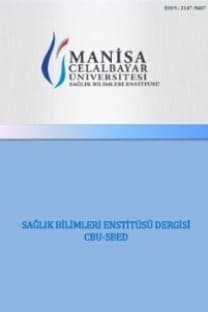AKUT TONSİLLOFARENJİTLER
Akut tonsillofarenjit erişkin ve çocuklarda en sık görülen enfeksiyonlardan biridir. Hastalığa ait belirti ve bulgular genellikle klinik tanının konulmasında yeterli olmakla birlikte, sadece klinik tabloya bakılarak bakteriyel ve viral etyolojinin ayrımının yapılması zordur. Özellikle bakteriyel tonsillofarenjit sonrası süpüratif (peritonsiller, parafarengeal, retrofarengeal apse) ve nonsüpüratif (akut romatizmal ateş, akut glomerülonefrit) ciddi komplikasyonlar gelişebilir. Bu nedenle akut tonsillofarenjitlerin ayırıcı tanısı, izlem ve tedavisi önemlidir. Bu derlemede akut tonsillofarenjitlerin etiyolojisi, epidemiyolojik ve klinik özellikleri, komplikasyonları, patogenezi, laboratuar tanısı ve tedavisi irdelenmiştir.
Anahtar Kelimeler:
A grubu beta hemolitik streptokok, akut tonsillofarenjit, tedavi
ACUTE TONSILLOPHARYNGITIS
Acute tonsillopharyngitis is one of the most common infection seen in adults and children. Although the symptoms and signs of this disease are usually sufficient to make a diagnosis, it is often difficult to make a distinction between bacterial and viral etiology on clinical grounds alone. The serious suppurative (peritonsillar, parapharyngeal, retropharyngeal abscess) and nonsuppurative (acute rheumatic fever, acute glomerulonephritis) complications may be occurred after the especially bacterial tonsillopharyngitis. For this reason differential diagnosis, management and treatment of acute tonsillopharyngitis are very important. In this review, we focus on the etiological, epidemiological and clinical features, complications, mechanisms of pathogenesis, laboratory diagnosis and on the treatment of acute tonsillopharyngitis.
___
- Morton LM, Wang SS, Devesa SS, et al. Lymphoma incidence patterns by WHO subtype in the United States, 1992-2001. Blood. 2006;107:265.
- Sant M, Allemani C, Tereanu C, et al. Incidence of hematologic malignancies in Europe by morphologic subtype: results of the HAEMACARE project. Blood. 2010;116:3724.
- Braeuninger A, Küppers R, Strickler JG, et al. Hodgkin and Reed-Sternberg cells in lymphocyte predominant Hodgkin disease represent clonal populations of germinal center-derived tumor B cells. Proc Natl Acad Sci U S A. 1997;94:9337.
- Marafioti T, Hummel M, Anagnostopoulos I, et al. Origin of nodular. lymphocyte-predominant Hodgkin's disease from a clonal expansion of highly mutated germinal-center B cells. N Engl J Med. 1997;337:453.
- Ohno T, Stribley JA, Wu G, et al. Clonality in nodular lymphocyte-predominant Hodgkin's disease. N Engl J Med. 1997;337:459.
- Schmitz R, Stanelle J, Hansmann ML, Küppers R. Pathogenesis of classical and lymphocyte-predominant Hodgkin lymphoma. Annu Rev Pathol. 2009; 4:151.
- Mauch PM, Kalish LA, Kadin M, et al. Patterns of presentation of Hodgkin disease. Implications for etiology and pathogenesis. Cancer. 1993;71:2062.
- Diehl V, Sextro M, Franklin J, et al. Clinical presentation, course, and prognostic factors in lymphocyte-predominant Hodgkin's disease and lymphocyte-rich classical Hodgkin's disease: report from the European Task Force on Lymphoma Project on Lymphocyte-Predominant Hodgkin's Disease. J Clin Oncol. 1999;17:776.
- Shimabukuro-Vornhagen A, Haverkamp H, Engert A, et al. Lymphocyte-rich classical Hodgkin's lymphoma: clinical presentation and treatment outcome in 100 patients treated within German Hodgkin's Study Group trials. J Clin Oncol. 2005;23:5739.
- National Comprehensive Cancer Network (NCCN 2.2015). NCCN
- http://www.nccn.org/professionals/physician_gls/f_guidelines.a sp
- Chen RC, Chin MS, Ng AK, et al. Early-stage, lymphocyte- predominant Hodgkin's lymphoma: patient outcomes from a large, single-institution series with long follow-up. J Clin Oncol. 2010;28:136.
- Wirth A, Yuen K, Barton M, et al. Long-term outcome after radiotherapy alone for lymphocyte-predominant Hodgkin lymphoma: a retrospective multicenter study of the Australasian Radiation Oncology Lymphoma Group. Cancer. 2005;104:1221. Nogová L, Reineke T, Eich HT, et al. Extended field radiotherapy, combined modality treatment or involved field radiotherapy for patients with stage IA lymphocyte-predominant Hodgkin's lymphoma: a retrospective analysis from the German Hodgkin Study Group (GHSG). Ann Oncol. 2005;16:1683.
- Wilder RB, Schlembach PJ, Jones D, et al. European Organization for Research and Treatment of Cancer and Groupe d'Etude des Lymphomes de l'Adulte very favorable and favorable, lymphocyte-predominant Hodgkin disease. Cancer. 2002;94:1731.
- Engert A, Franklin J, Eich HT, et al. Two cycles of doxorubicin, bleomycin, vinblastine, and dacarbazine plus extended-field radiotherapy is superior to radiotherapy alone in early favorable Hodgkin's lymphoma: final results of the GHSG HD7 trial. J Clin Oncol. 2007;25:3495.
- Hall GW, Katzilakis N, Pinkerton CR, et al. Outcome of children with nodular lymphocyte predominant Hodgkin lymphoma - a Children's Cancer and Leukaemia Group report. Br J Haematol. 2007;138:761.
- Fanale MA, Lai CM, McLaughlin P, et al. Outcomes of nodular lymphocyte predominant Hodgkin’s lymphoma (NLPHL) patients treated with R-CHOP [abstract]. Blood (ASH Annual Meeting Abstracts). 2010;116:2812.
- Bodis S, Kraus MD, Pinkus G, et al. Clinical presentation and outcome in lymphocyte-predominantHodgkin's disease. J Clin Oncol. 1997; 15:3060.
- Karuturi M, Hosing C, Fanale M, et al. High-dose chemotherapy and autologous stem cell transplantation for nodular lymphocyte-predominant Hodgkin lymphoma. Biol Blood Marrow Transplant. 2013;19:991. in
- oncology. 11. 12. 13. 14. 15. 16. 17. 18. 19.
- ISSN: 2147-9607
- Yayın Aralığı: Yılda 4 Sayı
- Başlangıç: 2014
- Yayıncı: Manisa Celal Bayar Üniversitesi Sağlık Bilimleri Enstitüsü
Sayıdaki Diğer Makaleler
KRONİK HEPATİT C'Lİ HASTALARDA İMMÜNOLOJİK GÖSTERGELER
Engin Kocabas, Sedef BAYATA, Yildiz Uyar, Aylin Turel ERMERTCAN
NODÜLER LENFOSİT BASKIN HODGKİN LENFOMA TEDAVİSİ
Zafer Gökgöz, Ali İhsan GEMİCİ, İsmet Aydoğdu
Feray ARAS, Zeliha Unlu, Nese Merve Kartal, Ozlem Erol
HBV ENFEKSİYONUYLA SAVAŞIMDA ÇOCUK, ADOLESAN VE GENÇ ERİŞKİN YAŞ GRUBUNUN AŞILANMASININ ÖNEMİ
Tahir BURAN, Selma TOSUN, Selahattin AKSU, Galip Koroglu, Fatma ESKİCİOGLU, Erhun Kasirga
